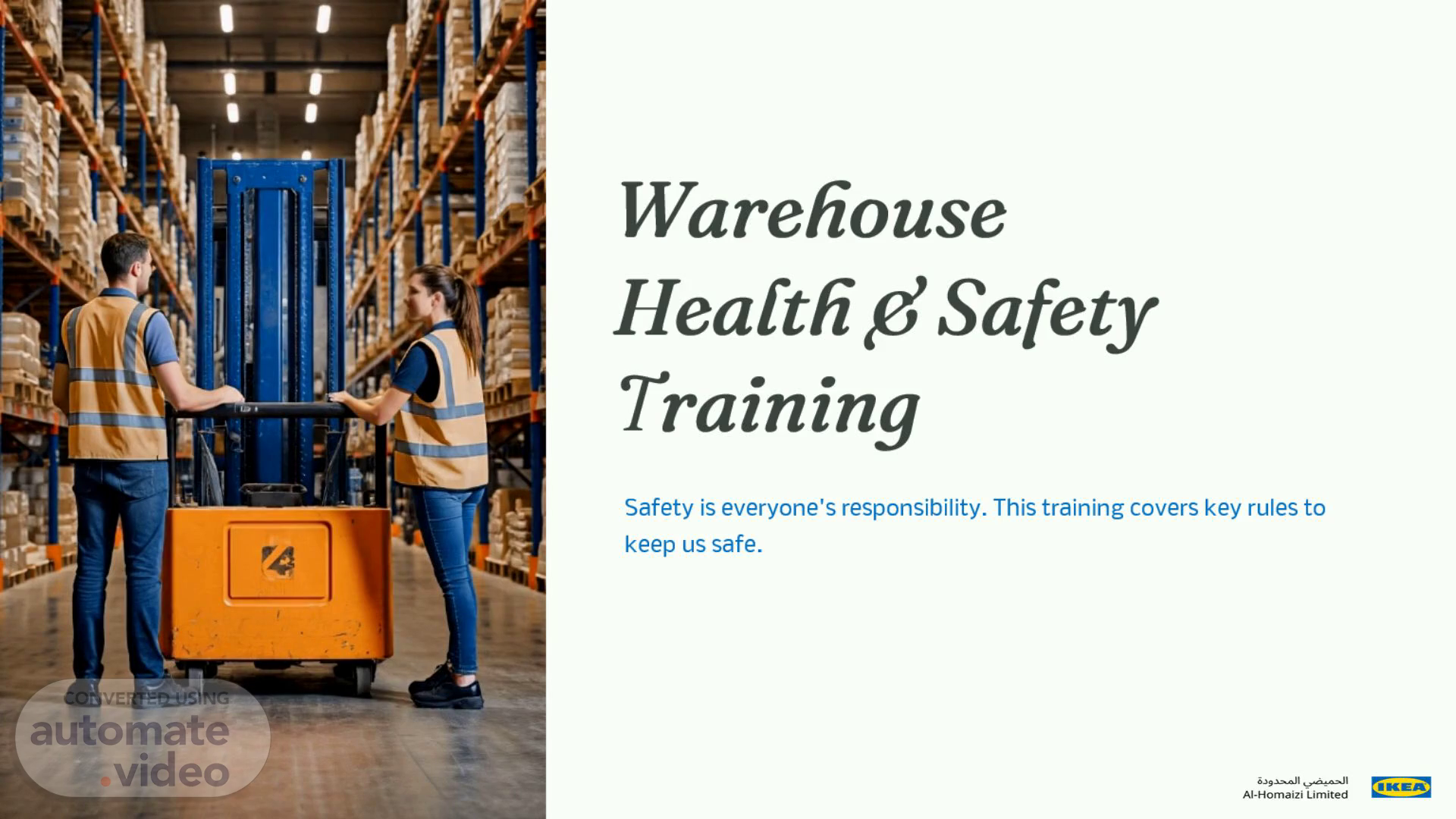Scene 1 (0s)
Safety is everyone's responsibility. This training covers key rules to keep us safe..
Scene 2 (9s)
Wear PPE Always use high-visibility vests, safety shoes, hard hats, and gloves if required..
Scene 3 (26s)
Operator Responsibilities Only trained and certified employees may operate MHE like forklifts and pallet jacks..
Scene 4 (52s)
[Audio] Pedestrian Safety preencoded.png Designated Walkways Always use marked paths and crosswalks to stay safe. preencoded.png Be Visible Make eye contact with operators before crossing M-H-E paths. preencoded.png Obey Signs Follow floor markings, warning lights, and stay clear of equipment zones..
Scene 5 (1m 16s)
[Audio] Storage and Stacking Safety Stack Securely Keep stacks stable, within height and weight limits. Keep Access Clear Do not block fire exits, aisles, or emergency equipment. Inspect Pallets Use pallets without damage or hazards like nails sticking out..
Scene 6 (1m 31s)
[Audio] M-H-E Charging Area Health & Safety Maintaining a safe and organized M-H-E charging area is crucial to prevent accidents and ensure operational efficiency. Adhere to the following guidelines: preencoded.png Fire Prevention Ensure charging areas are free from flammable materials. Have appropriate fire extinguishers readily available and inspected regularly. preencoded.png Proper Ventilation Charging batteries can release hazardous gases. Ensure adequate ventilation systems are in place to diffuse fumes and prevent accumulation. preencoded.png Spill Management Immediately clean up any battery acid or electrolyte spills using designated spill tools. Report larger spills to Team leader for proper handling. preencoded.png Electrical Safety Only trained personnel should connect/disconnect batteries. Inspect cables, connectors, and charging units for damage before each use. Avoid overloading electrical outlets. preencoded.png Clear Walkways Keep charging areas clear of obstructions and debris. Mark designated walkways and ensure they are always accessible..
Scene 7 (2m 42s)
[Audio] Housekeeping and Emergency Procedures Daily Cleaning Protocols: Clean spills immediately and dispose of waste properly. Maintain organized workstations and return tools to designated storage areas after use. Ensure aisles always remain clear of debris and obstructions. Fire Emergency Response: Memorize evacuation routes and assembly points. In case of fire, activate the nearest alarm, attempt to extinguish only if trained and safe to do so, and evacuate following marked exit routes. Medical Emergencies: Report all injuries immediately, no matter how minor. Know the location of first aid kits. Contact designated first aiders and follow their instructions until professional help arrives. Chemical Spill Procedures: Refer to S-D-S for specific handling instructions. Use appropriate P-P-E when cleaning chemical spills and cordon off affected areas. Report significant spills to your team leader for proper solution. Complete the warehouse safety checklist at the end of each shift to ensure all housekeeping standards are maintained. Remember: A clean warehouse is a safe warehouse, and proper emergency response saves lives..
Scene 8 (3m 53s)
[Audio] Incident Reporting preencoded.png Report All Report injuries, near misses, and unsafe acts immediately. preencoded.png Cooperate Fully Assist in investigations to prevent future incidents. preencoded.png Follow Procedures Use company forms or notify team leaders as required..
Scene 9 (4m 13s)
[Audio] Warehouse Daily Health & Safety Checks (Safety Officer) Conduct the following inspections at the beginning of each shift to ensure a safe working environment. Document findings and report any issues immediately to your Team leader. preencoded.png General Safety Inspection Check walkways are clear of obstructions, emergency exits are accessible, and safety signage is visible. Verify fire extinguishers and first aid kits are in place and properly stocked. preencoded.png Material Handling Equipment Inspect forklifts and equipment for damage, fluid leaks, or malfunction. Test horn, lights, and brakes. Ensure proper battery levels and charging status. preencoded.png Storage and Stacking Verify products are stacked safely with proper weight distribution. Check rack integrity and ensure load limits are respected. Confirm hazardous materials are properly stored and labeled. preencoded.png Housekeeping Assessment Look for spills, debris, or potential trip hazards. Check that cleaning supplies are available and waste disposal areas are not overflowing. Ensure charging areas are free from flammable materials. Complete the daily safety checklist form and submit to your Team Leader before beginning warehouse operations. Remember: Your vigilance in these daily checks directly contributes to preventing incidents and maintaining a safe workplace..
Scene 10 (5m 27s)
[Audio] Questions? Thanks!. Questions?. Thanks!.
